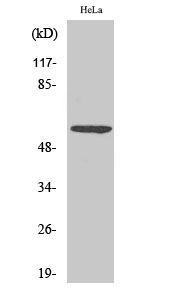Phospho G3BP1 (S232) Cell-Based Colorimetric ELISA Kit
- Catalog No.:KA1086C
- Applications:ELISA
- Reactivity:Human;Mouse
- Gene Name:
- G3BP1
- Human Gene Id:
- 10146
- Human Swiss Prot No:
- Q13283
- Mouse Swiss Prot No:
- P97855
- Storage Stability:
- 2-8°C/6 months
- Other Name:
- Ras GTPase-activating protein-binding protein 1 (G3BP-1) (EC 3.6.4.12) (EC 3.6.4.13) (ATP-dependent DNA helicase VIII) (hDH VIII) (GAP SH3 domain-binding protein 1)
- Detection Method:
- Colorimetric
- Background:
- cofactor:Magnesium. Required for helicase activity.,domain:The NTF2 domain mediates multimerization.,function:May be a regulated effector of stress granule assembly. Phosphorylation-dependent sequence-specific endoribonuclease in vitro. Cleaves exclusively between cytosine and adenine and cleaves MYC mRNA preferentially at the 3'-UTR. ATP- and magnesium-dependent helicase. Unwinds preferentially partial DNA and RNA duplexes having a 17 bp annealed portion and either a hanging 3' tail or hanging tails at both 5'- and 3'-ends. Unwinds DNA/DNA, RNA/DNA, and RNA/RNA substrates with comparable efficiency. Acts unidirectionally by moving in the 5' to 3' direction along the bound single-stranded DNA.,PTM:Arg-435 is dimethylated, probably to asymmetric dimethylarginine.,PTM:Phosphorylated exclusively on serine residues. Hyperphosphorylated in quiescent fibroblasts. Hypophosphorylation leads to a decrease in endoribonuclease activity (By similarity). RASA1-dependent phosphorylation of Ser-149 induces a conformational change that prevents self-association. Dephosphorylation after HRAS activation is required for stress granule assembly. Ser-149 phosphorylation induces partial nuclear localization.,similarity:Contains 1 NTF2 domain.,similarity:Contains 1 RRM (RNA recognition motif) domain.,subcellular location:Cytoplasmic in proliferating cells, can be recruited to the plasma membrane in exponentially growing cells (By similarity). Cytosolic and partially nuclear in resting cells. Recruited to stress granules (SGs) upon either arsenite or high temperature treatment. Recruitment to SGs is influenced by HRAS.,subunit:Binds to the SH3 domain of Ras GTPase-activating protein (RASA1) in proliferating cells. No interaction in quiescent cells Component of a TAU mRNP complex, at least composed of IGF2BP1, ELAVL4 and G3BP (By similarity). Interacts with USP10, and may regulate it. Forms homodimers and oligomers.,tissue specificity:Ubiquitous.,
- Function:
- intracellular signaling cascade, small GTPase mediated signal transduction, Ras protein signal transduction,
- Subcellular Location:
- Cytoplasm, cytosol . Perikaryon . Cytoplasm, Stress granule . Nucleus . Cytoplasmic in proliferating cells (PubMed:11604510). Cytosolic and partially nuclear in resting cells (PubMed:11604510). Recruited to stress granules in response to arsenite treatment (PubMed:12642610, PubMed:20180778). The unphosphorylated form is recruited to stress granules (PubMed:12642610). HRAS signaling contributes to this process by regulating G3BP dephosphorylation (PubMed:12642610). .
- Expression:
- Ubiquitous.
- June 19-2018
- WESTERN IMMUNOBLOTTING PROTOCOL
- June 19-2018
- IMMUNOHISTOCHEMISTRY-PARAFFIN PROTOCOL
- June 19-2018
- IMMUNOFLUORESCENCE PROTOCOL
- September 08-2020
- FLOW-CYTOMEYRT-PROTOCOL
- May 20-2022
- Cell-Based ELISA│解您多样本WB检测之困扰
- July 13-2018
- CELL-BASED-ELISA-PROTOCOL-FOR-ACETYL-PROTEIN
- July 13-2018
- CELL-BASED-ELISA-PROTOCOL-FOR-PHOSPHO-PROTEIN
- July 13-2018
- Antibody-FAQs


